OMNITROPE
-
somatropin injection, solution
OMNITROPE
-
somatropin
Sandoz Inc.
----------
Omnitrope (somatropin [rDNA origin]) Cartridges and for Injection
|
|||||||||||||||||||||
FULL PRESCRIBING INFORMATION
1. INDICATIONS AND USAGE
1.1 Pediatric Patients
Omnitrope® [somatropin (rDNA origin) injection] is indicated for the treatment of children with growth failure due to inadequate secretion of endogenous growth hormone (GH).
1.2 Adult Patients
Omnitrope® [somatropin (rDNA origin) injection] is indicated for the replacement of endogenous GH in adults with growth hormone deficiency (GHD) who meet either of the following two criteria:
- Adult Onset (AO): Patients who have GHD, either alone or associated with multiple hormone deficiencies (hypopituitarism), as a result of pituitary disease, hypothalamic disease, surgery, radiation therapy, or trauma; or
- Childhood Onset (CO): Patients who were GH deficient during childhood as a result of congenital, genetic, acquired, or idiopathic causes.
In general, confirmation of the diagnosis of adult GHD in both groups usually requires an appropriate GH stimulation test. However, confirmatory GH stimulation testing may not be required in patients with congenital/genetic GHD or multiple pituitary hormone deficiencies due to organic disease.
2. DOSAGE AND ADMINISTRATION
For subcutaneous injection.
Therapy with Omnitrope® should be supervised by a physician who is experienced in the diagnosis and management of pediatric patients with short stature associated with GHD and adult patients with either childhood onset or adult onset GHD.
2.1 Dosing of Pediatric Patients
General Pediatric Dosing Information
The Omnitrope® dosage and administration schedule should be individualized based on the growth response of each patient. Serum insulin-like growth factor I (IGF-I) levels may be useful during dose titration.
Response to somatropin therapy in pediatric patients tends to decrease with time. However, in pediatric patients, the failure to increase growth rate, particularly during the first year of therapy, indicates the need for close assessment of compliance and evaluation for other causes of growth failure, such as hypothyroidism, undernutrition, advanced bone age and antibodies to recombinant human GH (rhGH).
Treatment with Omnitrope® for short stature should be discontinued when the epiphyses are fused.
Pediatric Growth Hormone Deficiency (GHD)
Generally, a dosage of 0.16 - 0.24 mg/kg body weight/week, divided into 6 - 7 daily doses, is recommended.
2.2 Dosing of Adult Patients
Adult Growth Hormone Deficiency (GHD)
Based on the weight-based dosing utilized in clinical studies with another somatropin product, the recommended dosage at the start of therapy is not more than 0.04 mg/kg/week given as a daily subcutaneous injection. The dose may be increased at 4- to 8-week intervals according to individual patient requirements to not more than 0.08 mg/kg/week. Clinical response, side effects, and determination of age- and gender-adjusted serum IGF-I levels may be used as guidance in dose titration.
Alternatively, taking into account recent literature, a starting dose of approximately 0.2 mg/day (range, 0.15-0.30 mg/day) may be used without consideration of body weight. This dose can be increased gradually every 1-2 months by increments of approximately 0.1-0.2 mg/day, according to individual patient requirements based on the clinical response and serum IGF-I concentrations. During therapy, the dose should be decreased if required by the occurrence of adverse events and/or serum IGF-I levels above the age- and gender-specific normal range. Maintenance dosages vary considerably from person to person.
A lower starting dose and smaller dose increments should be considered for older patients, who are more prone to the adverse effects of somatropin than younger individuals. In addition, obese individuals are more likely to manifest adverse effects when treated with a weight-based regimen. In order to reach the defined treatment goal, estrogen-replete women may need higher doses than men. Oral estrogen administration may increase the dose requirements in women.
2.3 Preparation and Administration
Omnitrope® Cartridge 5 mg/1.5 mL and Cartridge 10 mg/1.5 mL
Each cartridge of Omnitrope® must be inserted into its corresponding Omnitrope® Pen 5 or Omnitrope® Pen 10 delivery system. Instructions for delivering the dosage are provided in the Omnitrope® INSTRUCTIONS FOR USE booklet enclosed with the Omnitrope® drug and the Omnitrope® Pens.
OMNITROPE® for injection 1.5 mg/vial and 5.8 mg/vial
Instructions for delivering the dosage are provided in the INSTRUCTIONS FOR USE leaflets enclosed with the Omnitrope® drug.
Once the diluent is added to the lyophilized powder, swirl gently; do not shake. Shaking may cause denaturation of the active ingredient.
Parenteral drug products should always be inspected visually for particulate matter and discoloration prior to administration, whenever solution and container permit. Omnitrope® MUST NOT BE INJECTED if the solution is cloudy or contains particulate matter. Use it only if it is clear and colorless. Omnitrope must be refrigerated at 2° to 8°C (36° to 46°F).
Patients and caregivers who will administer OMNITROPE® in medically unsupervised situations should receive appropriate training and instruction on the proper use of OMNITROPE® from the physician or other suitably qualified health professional.
The dosage of OMNITROPE® must be adjusted for the individual patient. The dose should be given daily by subcutaneous injections (administered preferably in the evening). OMNITROPE® may be given in the thigh, buttocks, or abdomen.
Injection sites should always be rotated to avoid lipoatrophy.
3. DOSAGE FORMS AND STRENGTHS
Omnitrope® Cartridges and vials (for injection) are available:
- 5 mg/1.5 mL Cartridge is a prefilled sterile somatropin solution containing benzyl alcohol in a glass cartridge ready to be administered with the Omnitrope® Pen 5.
- 10 mg/1.5 mL Cartridge is a prefilled sterile somatropin solution in a glass cartridge ready to be administered with the Omnitrope® Pen 10.
- 1.5 mg/vial is supplied with two vials, one containing somatropin as a powder and the other vial containing the diluent (Sterile Water for Injection).
- 5.8 mg/vial is supplied with two vials, one containing somatropin as a powder and the other vial containing diluent (Bacteriostatic Water for Injection containing benzyl alcohol as a preservative).
4. CONTRAINDICATIONS
4.1 Acute Critical Illness
Treatment with pharmacologic amounts of somatropin is contraindicated in patients with acute critical illness due to complications following open heart surgery, abdominal surgery or multiple accidental trauma, or those with acute respiratory failure. Two placebo-controlled clinical trials in non-growth hormone deficient adult patients (n=522) with these conditions in intensive care units revealed a significant increase in mortality (41.9% vs. 19.3%) among somatropin-treated patients (doses 5.3-8 mg/day) compared to those receiving placebo [see WARNINGS AND PRECAUTIONS (5.1)].
4.2 Prader-Willi Syndrome in Children
Somatropin is contraindicated in patients with Prader-Willi syndrome who are severely obese, have a history of upper airway obstruction or sleep apnea, or have severe respiratory impairment. There have been reports of sudden death when somatropin was used in such patients. Omnitrope® is not indicated for the treatment of pediatric patients who have growth failure due to genetically confirmed Prader-Willi syndrome.
4.3 Active Malignancy
In general, somatropin is contraindicated in the presence of active malignancy. Any preexisting malignancy should be inactive and its treatment complete prior to instituting therapy with somatropin. Somatropin should be discontinued if there is evidence of recurrent activity. Since GHD may be an early sign of the presence of a pituitary tumor (or, rarely, other brain tumors), the presence of such tumors should be ruled out prior to initiation of treatment. Somatropin should not be used in patients with any evidence of progression or recurrence of an underlying intracranial tumor.
4.4 Diabetic Retinopathy
Somatropin is contraindicated in patients with active proliferative or severe non-proliferative diabetic retinopathy.
4.5 Closed Epiphyses
Somatropin should not be used for growth promotion in pediatric patients with closed epiphyses.
4.6 Hypersensitivity
Omnitrope® is contraindicated in patients with a known hypersensitivity to somatropin or any of its excipients. Localized reactions are the most common hypersensitivity reactions.
4.7 Benzyl Alcohol Sensitivity
Benzyl alcohol, a preservative in Omnitrope Cartridge 5 mg/1.5 mL and in Bacteriostatic Water for Injection, has been associated with toxicity in newborns.
Omnitrope Cartridge 5 mg/1.5 mL and Omnitrope for Injection 5.8 mg/vial must not be given to premature babies or neonates.
5. WARNINGS AND PRECAUTIONS
5.1 Acute Critical Illness
Increased mortality in patients with acute critical illness due to complications following open heart surgery, abdominal surgery or multiple accidental trauma, or those with acute respiratory failure has been reported after treatment with pharmacologic amounts of somatropin [see CONTRAINDICATIONS (4.1)]. The safety of continuing somatropin treatment in patients receiving replacement doses for approved indications who concurrently develop these illnesses has not been established. Therefore, the potential benefit of treatment continuation with somatropin in patients experiencing acute critical illnesses should be weighed against the potential risk.
5.2 Neoplasms
Patients with preexisting tumors or GHD secondary to an intracranial lesion should be monitored routinely for progression or recurrence of the underlying disease process. In pediatric patients, clinical literature has revealed no relationship between somatropin replacement therapy and central nervous system (CNS) tumor recurrence or new extracranial tumors. However, in childhood cancer survivors, an increased risk of a second neoplasm has been reported in patients treated with somatropin after their first neoplasm. Intracranial tumors, in particular meningiomas, in patients treated with radiation to the head for their first neoplasm, were the most common of these second neoplasms. In adults, it is unknown whether there is any relationship between somatropin replacement therapy and CNS tumor recurrence.
Patients should be monitored carefully for potential malignant transformation of skin lesions, i.e. increased growth of preexisting nevi.
5.3 Glucose Intolerance
Treatment with somatropin may decrease insulin sensitivity, particularly at higher doses in susceptible patients. As a result, previously undiagnosed impaired glucose tolerance and overt diabetes mellitus may be unmasked during somatropin treatment. Therefore, glucose levels should be monitored periodically in all patients treated with somatropin, especially in those with risk factors for diabetes mellitus, such as obesity or a family history of diabetes mellitus. Patients with preexisting type 1 or type 2 diabetes mellitus or impaired glucose tolerance should be monitored closely during somatropin therapy. The doses of antihyperglycemic drugs (i.e., insulin or oral agents) may require adjustment when somatropin therapy is instituted in these patients.
5.4 Intracranial Hypertension (IH)
Intracranial hypertension (IH) with papilledema, visual changes, headache, nausea, and/or vomiting has been reported in a small number of patients treated with somatropin products. Symptoms usually occurred within the first eight (8) weeks after the initiation of somatropin therapy. In all reported cases, IH-associated signs and symptoms rapidly resolved after cessation of therapy or a reduction of the somatropin dose.
Funduscopic examination should be performed routinely before initiating treatment with somatropin to exclude preexisting papilledema, and periodically during the course of somatropin therapy. If papilledema is observed by funduscopy during somatropin treatment, treatment should be stopped. If somatropin-induced IH is diagnosed, treatment with somatropin can be restarted at a lower dose after IH-associated signs and symptoms have resolved.
5.5 Fluid Retention
Fluid retention during somatropin replacement therapy in adults may frequently occur. Clinical manifestations of fluid retention are usually transient and dose dependent.
5.6 Hypothyroidism
Undiagnosed/untreated hypothyroidism may prevent an optimal response to somatropin, in particular, the growth response in children. Patients with an inherently increased risk of developing autoimmune thyroid disease and primary hypothyroidism should have their thyroid function checked prior to initiation of somatropin therapy. In patients with GHD, central (secondary) hypothyroidism may first become evident or worsen during somatropin treatment. Therefore, patients treated with somatropin should have periodic thyroid function tests and thyroid hormone replacement therapy should be initiated or appropriately adjusted when indicated.
In patients with hypopituitarism (multiple hormone deficiencies), standard hormonal replacement therapy should be monitored closely when somatropin therapy is administered.
5.7 Slipped Capital Femoral Epiphysis in Pediatric Patients
Slipped capital femoral epiphysis may occur more frequently in patients undergoing rapid growth. Any pediatric patient with the onset of a limp or complaints of hip or knee pain during somatropin therapy should be carefully evaluated.
5.8 Progression of Preexisting Scoliosis in Pediatric Patients
Progression of scoliosis can occur in patients who experience rapid growth. Because somatropin increases growth rate, patients with a history of scoliosis who are treated with somatropin should be monitored for progression of scoliosis. However, somatropin has not been shown to increase the occurrence of scoliosis.
5.9 Confirmation of Childhood Onset Adult GHD
Patients with epiphyseal closure who were treated with somatropin replacement therapy in childhood should be reevaluated according to the criteria in INDICATIONS AND USAGE (1.2) before continuation of somatropin therapy at the reduced dose level recommended for GH deficient adults.
5.10 Local and Systemic Reactions
When somatropin is administered subcutaneously at the same site over a long period of time, tissue atrophy may result. This can be avoided by rotating the injection site [see DOSAGE AND ADMINISTRATION (2.3)].
As with any protein, local or systemic allergic reactions may occur. Parents/Patients should be informed that such reactions are possible and that prompt medical attention should be sought if allergic reactions occur.
5.11 Laboratory Tests
Serum levels of inorganic phosphorus, alkaline phosphatase, parathyroid hormone (PTH) and IGF-I may increase after somatropin therapy.
6. ADVERSE REACTIONS
6.1 Most Serious and/or Most Frequently Observed Adverse Reactions
This list presents the most seriousb and/or most frequently observeda adverse reactions during treatment with somatropin:
- bSudden death in pediatric patients with Prader-Willi syndrome with risk factors including severe obesity, history of upper airway obstruction or sleep apnea and unidentified respiratory infection [see CONTRAINDICATIONS (4.2)]
- bIntracranial tumors, in particular meningiomas, in teenagers/young adults treated with radiation to the head as children for a first neoplasm and somatropin [see CONTRAINDICATIONS (4.3) and WARNINGS AND PRECAUTIONS (5.3)]
- a,bGlucose intolerance including impaired glucose tolerance/impaired fasting glucose as well as overt diabetes mellitus [WARNINGS AND PRECAUTIONS (5.4)]
- bIntracranial hypertension [see WARNINGS AND PRECAUTIONS (5.5)]
- bSignificant diabetic-retinopathy [see CONTRAINDICATIONS (4.4)]
- bSlipped capital femoral epiphysis in pediatric patients [see WARNINGS AND PRECAUTIONS (5.8)]
- bProgression of preexisting scoliosis in pediatric patients [see WARNINGS AND PRECAUTIONS (5.9)]
- aFluid retention manifested by edema, arthralgia, myalgia, nerve compression syndromes including carpal tunnel syndrome/paraesthesias [see WARNINGS AND PRECAUTIONS (5.6)]
- aUnmasking of latent central hypothyroidism [see WARNINGS AND PRECAUTIONS (5.7)]
- aInjection site reactions/rashes and lipoatrophy (as well as rare generalized hypersensitivity reactions) [see WARNINGS AND PRECAUTIONS (5.11)]
6.2 Clinical Trials Experience
Because clinical trials are conducted under varying conditions, adverse reaction rates observed during the clinical trials performed with one somatropin formulation cannot always be directly compared to the rates observed during the clinical trials performed with a second somatropin formulation, and may not reflect the adverse reaction rates observed in practice.
Clinical Trials in Pediatric GHD Patients
As with all protein drugs, a small percentage of patients may develop antibodies to the protein. GH antibodies with binding capacities lower than 2 mg/L have not been associated with growth attenuation. In a very small number of patients, when binding capacity was greater than 2 mg/L, interference with the growth response was observed.
The following events were observed during clinical studies with OMNITROPE® Cartridge conducted in children with GHD:
| Adverse Event | Number (%) |
| Elevated HbA1c | 14 |
| Eosinophilia | 12 |
| Hematoma | 9 |
The following events were observed during clinical studies with OMNITROPE® for injection conducted in children with GHD:
| Adverse Event | Number (%) |
| Hypothyroidism | 16% |
| Elevated HbA1c | 14% |
| Eosinophilia | 11% |
| Hematoma | 9% |
| Headache | 7% |
| Hypertriglyceridemia | 5% |
| Leg Pain | 5% |
Clinical Trials in Adult GHD Patients
In clinical trials with somatropin in GHD adults, the majority of the adverse events consisted of mild to moderate symptoms of fluid retention, including peripheral swelling, arthralgia, pain and stiffness of the extremities, peripheral edema, myalgia, paresthesia, and hypoesthesia. These events were reported early during therapy, and tended to be transient and/or responsive to dosage reduction.
6.3 Post-Marketing Surveillance
Because these adverse events are reported voluntarily from a population of uncertain size, it is not always possible to reliably estimate their frequency or establish a causal relationship to drug exposure. The adverse events reported during post-marketing surveillance do not differ from those listed/discussed above in Sections 6.1 and 6.2 in children and adults.
Leukemia has been reported in a small number of GH deficient children treated with somatropin, somatrem (methionylated rhGH) and GH of pituitary origin. It is uncertain whether these cases of leukemia are related to GH therapy, the pathology of GHD itself, or other associated treatments such as radiation therapy. On the basis of current evidence, experts have not been able to conclude that GH therapy per se was responsible for these cases of leukemia. The risk for children with GHD, if any, remains to be established [see CONTRAINDICATIONS (4.3) and WARNINGS AND PRECAUTIONS (5.2)].
The following additional adverse reactions have been observed during the use of somatropin: headaches (children and adults), gynecomastia (children), and pancreatitis (children).
7. DRUG INTERACTIONS
7.1 Inhibition of 11β-Hydroxysteroid Dehydrogenase Type 1 (11βHSD-1)
Somatropin inhibits 11β-hydroxysteroid dehydrogenase type 1 (11βHSD-1) in adipose/hepatic tissue and may significantly impact the metabolism of cortisol and cortisone. As a consequence, in patients treated with somatropin, previously undiagnosed central (secondary) hypoadrenalism may be unmasked requiring glucocorticoid replacement therapy. In addition, patients treated with glucocorticoid replacement therapy for previously diagnosed hypoadrenalism may require an increase in their maintenance or stress doses; this may be especially true for patients treated with cortisone acetate and prednisone since conversion of these drugs to their biologically active metabolites is dependent on the activity of the 11βHSD-1 enzyme.
7.2 Glucocorticoid Replacement
Excessive glucocorticoid therapy may attenuate the growth promoting effects of somatropin in children. Therefore, glucocorticoid replacement therapy should be carefully adjusted in children with concomitant GH and glucocorticoid deficiency to avoid both hypoadrenalism and an inhibitory effect on growth.
7.3 Cytochrome P450-Metabolized Drugs
Limited published data indicate that somatropin treatment increases cytochrome P450 (CYP450)-mediated antipyrine clearance in man. These data suggest that somatropin administration may alter the clearance of compounds known to be metabolized by CYP450 liver enzymes (e.g., corticosteroids, sex steroids, anticonvulsants, cyclosporine). Careful monitoring is advisable when somatropin is administered in combination with other drugs known to be metabolized by CYP450 liver enzymes. However, formal drug interaction studies have not been conducted.
7.4 Oral Estrogen
In adult women on oral estrogen replacement, a larger dose of somatropin may be required to achieve the defined treatment goal [see DOSAGE AND ADMINISTRATION (2.2)].
7.5 Insulin and/or Oral Hypoglycemic Agents
In patients with diabetes mellitus requiring drug therapy, the dose of insulin and/or oral agent may require adjustment when somatropin therapy is initiated [see WARNINGS AND PRECAUTIONS (5.4)].
8. USE IN SPECIFIC POPULATIONS
8.1 Pregnancy
Pregnancy Category B
Animal reproduction studies have not been conducted with Omnitrope®. It is not known whether Omnitrope® can cause fetal harm when administered to a pregnant woman or can affect reproductive capacity.
Reproduction studies carried out with another approved somatropin product at doses of 0.3, 1, and 3.3 mg/kg/day administered subcutaneously in the rat and 0.08, 0.3, and 1.3 mg/kg/day administered intramuscularly in the rabbit (highest doses approximately 24 times and 19 times the recommended human therapeutic levels, respectively, based on body surface area) resulted in decreased maternal body weight gains but were not teratogenic. In rats receiving subcutaneous doses during gametogenesis and up to 7 days of pregnancy, 3.3 mg/kg/day (approximately 24 times human dose) produced anestrus or extended estrus cycles in females and fewer and less motile sperm in males. When given to pregnant female rats (days 1 to 7 of gestation) at 3.3 mg/kg/day a very slight increase in fetal deaths was observed. At 1 mg/kg/day (approximately seven times human dose) rats showed slightly extended estrus cycles, whereas at 0.3 mg/kg/day no effects were noted.
In perinatal and postnatal studies in rats, somatropin doses of 0.3, 1, and 3.3 mg/kg/day of another approved somatropin product produced growth-promoting effects in the dams but not in the fetuses. Young rats at the highest dose showed increased weight gain during suckling but the effect was not apparent by 10 weeks of age. No adverse effects were observed on gestation, morphogenesis, parturition, lactation, postnatal development, or reproductive capacity of the offsprings due to another approved somatropin product. There are, however, no adequate and well-controlled studies in pregnant women. Because animal reproduction studies are not always predictive of human response, this drug should be used during pregnancy only if clearly needed.
8.3 Nursing Mothers
It is not known whether Omnitrope® is excreted in human milk. Because many drugs are excreted in human milk, caution should be exercised when Omnitrope® is administered to a nursing woman.
8.5 Geriatric Use
The safety and effectiveness of Omnitrope® in patients aged 65 and over have not been evaluated in clinical studies. Elderly patients may be more sensitive to the action of somatropin, and therefore may be more prone to develop adverse reactions. A lower starting dose and smaller dose increments should be considered for older patients [see DOSAGE AND ADMINISTRATION (2.2)].
10. OVERDOSAGE
Short-Term
Short-term overdosage could lead initially to hypoglycemia and subsequently to hyperglycemia. Furthermore, overdose with somatropin is likely to cause fluid retention.
Long-Term
Long-term overdosage could result in signs and symptoms of gigantism and/or acromegaly consistent with the known effects of excess growth hormone [see DOSAGE AND ADMINISTRATION (2)].
11. DESCRIPTION
OMNITROPE® (somatropin-[rDNA] origin) is a polypeptide hormone of recombinant DNA origin. It has 191 amino acid residues and a molecular weight of 22,125 daltons. The amino acid sequence of the product is identical to that of human growth hormone of pituitary origin (somatropin). OMNITROPE® is synthesized in a strain of. Escherichia coli that has been modified by the addition of the gene for human growth hormone. OMNITROPE® Cartridge is a clear, colorless, sterile solution for subcutaneous injection. OMNITROPE® for Injection is a lyophilized powder that is reconstituted for subcutaneous injection.
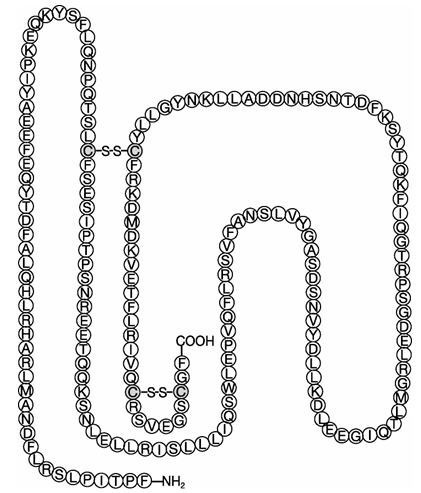
Figure 1. Schematic amino acid sequence of human growth hormone including the disulfide bonds
The bioidentity of the recombinant protein is measured by comparing its growth inducing effect with the growth inducing effect of a reference preparation calibrated in International Units.
Each Omnitrope® Cartridge or vial contains the following (see TABLE 3 ):
|
Product |
Cartridge 5 mg/ 1.5 mL |
Cartridge 10 mg/ 1.5 mL |
For Injection 1.5 mg/ vial |
For Injection 5.8 mg/ vial |
| Component | ||||
| Somatropin | 5 mg | 10 mg | 1.5 mg | 5.8 mg |
|
Disodium hydrogen phosphate heptahydrate |
1.3 mg |
1.70 mg |
0.88 mg |
2.09 mg |
|
Sodium dihydrogen phosphate dihydrate |
1.6 mg |
1.35 mg |
0.21 mg |
0.56 mg |
| Poloxamer 188 | 3.0 mg | 3.0 mg | - | - |
| Mannitol | 52.5 mg | - | - | - |
| Glycine | - | 27.75 mg | 27.6 mg | 27.6 mg |
| Benzyl alcohol | 13.5 mg | - | - | - |
| Phenol | - | 4.50 mg | - | - |
|
Water for Injection |
to make 1.5 mL |
to make 1.5 mL |
- |
- |
| Diluent (vials only) |
Water for Injection |
Bacteriostatic Water for Injection |
||
|
Water for injection |
1.13 mL |
to make 1.14 mL |
||
| Benzyl alcohol | - | 17 mg |
12. CLINICAL PHARMACOLOGY
12.1 Mechanism Of Action
Somatropin (as well as endogenous GH) binds to a dimeric GH receptor in the cell membrane of target cells resulting in intracellular signal transduction and a host of pharmacodynamic effects. Some of these pharmacodynamic effects are primarily mediated by IGF-I produced in the liver and also locally (e.g., skeletal growth, protein synthesis), while others are primarily a consequence of the direct effects of somatropin (e.g., lipolysis) [see CLINICAL PHARMACOLOGY (12.2)].
12.2 Pharmacodynamics
Tissue Growth
The primary and most intensively studied action of somatropin is the stimulation of linear growth. This effect is demonstrated in children with GHD.
Skeletal Growth
The measurable increase in bone length after administration of somatropin results from its effect on the cartilaginous growth areas of long bones. Studies in vitro have shown that the incorporation of sulfate into proteoglycans is not due to a direct effect of somatropin, but rather is mediated by the somatomedins or insulin-like growth factors (IGFs). The somatomedins, among them IGF-I, are polypeptide hormones which are synthesized in the liver, kidney, and various other tissues. IGF-I levels are low in the serum of hypopituitary dwarfs and hypophysectomized humans or animals, and increase after treatment with somatropin.
Cell Growth
It has been shown that the total number of skeletal muscle cells is markedly decreased in children with short stature lacking endogenous GH compared with normal children, and that treatment with somatropin results in an increase in both the number and size of muscle cells.
Organ Growth
Somatropin influences the size of internal organs, and it also increases red cell mass.
Protein Metabolism
Linear growth is facilitated in part by increased cellular protein synthesis. This synthesis and growth are reflected by nitrogen retention which can be quantitated by observing the decline in urinary nitrogen excretion and blood urea nitrogen following the initiation of somatropin therapy.
Carbohydrate Metabolism
Hypopituitary children sometimes experience fasting hypoglycemia that may be improved by treatment with somatropin. In healthy subjects, large doses of somatropin may impair glucose tolerance. Although the precise mechanism of the diabetogenic effect of somatropin is not known, it is attributed to blocking the action of insulin rather than blocking insulin secretion. Insulin levels in serum actually increase as somatropin levels increase. Administration of human growth hormone to normal adults and patients with growth hormone deficiency results in increases in mean serum fasting and postprandial insulin levels, although mean values remain in the normal range. In addition, mean fasting and postprandial glucose and hemoglobin A1C levels remain in the normal range.
Lipid Metabolism
Somatropin stimulates intracellular lipolysis, and administration of somatropin leads to an increase in plasma free fatty acids and triglycerides. Untreated GHD is associated with increased body fat stores, including increased abdominal visceral and subcutaneous adipose tissue. Treatment of growth hormone deficient patients with somatropin results in a general reduction of fat stores, and decreased serum levels of low density lipoprotein (LDL) cholesterol.
Mineral Metabolism
Administration of somatropin results in an increase in total body potassium and phosphorus and to a lesser extent sodium. This retention is thought to be the result of cell growth. Serum levels of phosphate increase in children with GHD after somatropin therapy due to metabolic activity associated with bone growth. Serum calcium levels are not altered. Although calcium excretion in the urine is increased, there is a simultaneous increase in calcium absorption from the intestine. Negative calcium balance, however, may occasionally occur during somatropin treatment.
Connective Tissue Metabolism
Somatropin stimulates the synthesis of chondroitin sulfate and collagen, and increases the urinary excretion of hydroxyproline.
12.3 Pharmacokinetics
Following a subcutaneous injection of single dose of 5 mg OMNITROPE® 5 mg/1.5 mL Cartridge in healthy male and female adults, the peak concentration (Cmax) and tmax values were 72 ± 28 mcg/L and 4.0 ± 2.0 hours, respectively. There are no pharmacokinetic data from patients with GHD.
The mean terminal half-life of somatropin after subcutaneous administration of OMNITROPE® Cartridge in healthy adults is 2.8 hours. The mean clearance of subcutaneously administered OMNITROPE® Cartridge in healthy adults was 0.14 (± 0.04) L/hr∙kg.
Following a subcutaneous injection of single dose of 5 mg OMNITROPE® 10 mg/1.5 mL Cartridge in healthy male and female adults, the peak concentration (Cmax) and tmax values were 74 ± 22 mcg/L and 4.0 ± 2.0 hours, respectively. There are no pharmacokinetic data from patients with GHD.
The mean terminal half-life of somatropin after subcutaneous administration of OMNITROPE® Cartridge in healthy adults is 2.5 hours. The mean clearance of subcutaneously administered OMNITROPE® Cartridge in healthy adults was 0.13 (± 0.02) L/hr∙kg.
The aqueous formulations 5 mg/1.5 mL Omnitrope® cartridge and 10 mg/mL Omnitrope® cartridge are bioequivalent to the lyophilized 5.8 mg/vial Omnitrope® formulation.
13. NONCLINICAL TOXICOLOGY
13.1 Carcinogenesis, Mutagenesis, Impairment Of Fertility
Carcinogenicity, mutagenicity, and fertility studies have not been conducted with Omnitrope®.
14. CLINICAL STUDIES
14.1 Pediatric Growth Hormone Deficiency (GHD)
The efficacy and safety of OMNITROPE® were compared with another somatropin approved for growth hormone deficiency (GHD) in pediatric patients. In sequential clinical trials involving a total of 89 GHD children, 44 patients received OMNITROPE® for injection 5.8 mg/vial and 45 patients received the comparator somatropin for 9 months. After 9 months of treatment patients who had received the somatropin comparator switched to OMNITROPE® Cartridge 5 mg/1.5 mL. After 15 months of treatment, all patients were switched to OMNITROPE® Cartridge to collect long-term efficacy and safety data for OMNITROPE® Cartridge.
In both groups, somatropin was administered as a daily subcutaneous injection at a dose of 0.03 mg/kg. Similar effects on growth were observed between OMNITROPE® powder and the comparator somatropin during the initial 9 months of treatment.
The efficacy results after 9 months of treatment (OMNITROPE® powder vs. the comparator somatropin) and after 15 months (OMNITROPE® Cartridge) are summarized in Table 4.
|
||
| Treatment Duration |
Treatment Group |
Treatment Group |
|
0 - 9 months |
OMNITROPE® for Injection (N=44) |
Somatropin (N=45) |
|
9 - 15 months |
OMNITROPE® for Injection (N=42) |
OMNITROPE® Cartridge (N=44) |
| Treatment Parameter | Mean (SD) | Mean (SD) |
| Height velocity (cm/yr) | ||
| Pre-treatment | 3.8 (1.2) | 4.0 (0.8) |
| Month 9 | 10.7 ( 2.6) | 10.7 (2.9) |
| Month 15 | 8.5 (1.8) | 8.6 (2.0) |
| Height velocity SDS | ||
| Pre-treatment | -2.4 (1.3) | -2.3 (1.1) |
| Month 9 | 6.1 (3.7) | 5.4 (3.2) |
| Month 15 | 3.4 (2.6) | 3.2 (2.9) |
| Height SDS | ||
| Pre-treatment | -3.0 (0.7) | -3.1 (0.9) |
| Month 9 | -2.3 (0.7) | -2.5 (0.7) |
| Month 15 | -2.0 (0.7) | -2.2 (0.7) |
| IGF-1* | ||
| Pre-treatment | 159 (92) | 158 (43) |
| Month 9 | 291 (174) | 302 (183) |
| Month 15 | 300 (225) | 323 (189) |
| IGFBP-3* | ||
| Pre-treatment | 3.5 (1.3) | 3.5 (1.0) |
| Month 9 | 4.6 (3.0) | 4.0 (1.5) |
| Month 15 | 4.6 (1.3) | 4.9 (1.4) |
14.2 Adult Growth Hormone Deficiency (GHD)
Randomized, placebo-controlled clinical trials with somatropin have been conducted in adult GHD patients. In these trials, beneficial changes in body composition were observed at the end of a 6-month treatment period for patients receiving somatropin as compared with the placebo patients. Lean body mass, total body water, and lean/fat ratio increased, while total body fat mass and waist circumference decreased. These effects on body composition were maintained when treatment was continued beyond 6 months. Bone mineral density declined after 6 months of treatment but returned to baseline values after 12 months of treatment.
16. HOW SUPPLIED/STORAGE AND HANDLING
Storage
Store OMNITROPE® refrigerated at 2° to 8°C (36° to 46°F).
Do not freeze.
OMNITROPE® is light sensitive and should be stored in the carton.
16.1 OMNITROPE® Cartridge 5 mg/1.5 mL
OMNITROPE® Cartridge (somatropin-[rDNA origin]) 5 mg/1.5 mL (15 IU) is supplied in the following package sizes:
- One cartridge (NDC 0781-3001-07)
- Five cartridges (NDC 0781-3001-26)
- Ten cartridges (NDC 0781-3001-44).
For use only with the OMNITROPE® Pen 5 delivery system, which is sold separately After the first use the cartridge should remain in the pen and has to be kept in a refrigerator at 2° to 8°C (36° to 46°F) for a maximum of 21 days.
16.2 OMNITROPE® Cartridge 10 mg/1.5 mL
OMNITROPE® Cartridge (somatropin-[rDNA origin]) 10 mg/1.5 mL (30 IU) is supplied in the following package sizes:
- One cartridge (NDC 0781-3004-07)
- Five cartridges (NDC 0781-3004-26)
- Ten cartridges (NDC 0781-3004-44).
For use only with the OMNITROPE® Pen 10 delivery system, which is sold separately After the first use the cartridge should remain in the pen and has to be kept in a refrigerator at 2° to 8°C (36° to 46°F) for a maximum of 28 days.
16.3 OMNITROPE® (somatropin [rDNA origin]) for injection 1.5 mg/vial
After reconstitution, the concentration is 1.33 mg/mL (approximately 4 IU/mL).
Carton contains 1 vial of OMNITROPE® 1.5 mg and 1 vial of diluent (Sterile Water for Injection).
NDC 0781-4002-32
OMNITROPE® 1.5 mg is supplied with a diluent without preservative.
After reconstitution, the vial may be stored under refrigeration for up to 24 hours.
Use once and discard any remaining solution.
16.4 OMNITROPE® (somatropin [rDNA origin]) for injection 5.8 mg/vial
After reconstitution, the concentration is 5 mg/mL (approximately 15 IU/mL).
Carton contains 8 vials of OMNITROPE® 5.8 mg and 8 vials of diluent (Bacteriostatic Water for Injection containing 1.5% benzyl alcohol as a preservative.)
NDC 0781-4004-36
OMNITROPE® 5.8 mg is supplied with a diluent containing benzyl alcohol as a preservative. After reconstitution, the contents of the vial must be used within 3 weeks. After the first injection, the vial should be stored in the carton in a refrigerator at 2° to 8°C (36° to 46°F)
|
Omnitrope® Product Formulation |
Storage Requirement |
|
| Before Use |
In-use (after 1st injection) |
|
|
5 mg/1.5 mL cartridge |
2-8ºC/ 36-46ºF Until exp date |
2-8 ºC/36-46 ºF 3 weeks |
|
10 mg/1.5 mL cartridge |
2-8 ºC/36-46 ºF 4 weeks |
|
|
1.5 mg/vial |
2-8 ºC/36-46 ºF 24 hours |
|
|
5.8 mg/vial |
2-8 ºC/36-46 ºF 3 weeks |
|
17. PATIENT COUNSELING INFORMATION
See FDA-approved patient labeling.
Patients being treated with OMNITROPE® (and/or their parents) should be informed about the potential risks and benefits associated with somatropin treatment [in particular, see ADVERSE REACTIONS (6.1) for a listing of the most serious and/or most frequently observed adverse reactions associated with somatropin treatment in children and adults]. This information is intended to better educate patients (and caregivers); it is not a disclosure of all possible adverse or intended effects.
Patients and caregivers who will administer OMNITROPE® should receive appropriate training and instruction on the proper use of OMNITROPE® from the physician or other suitably qualified health care professional. A puncture-resistant container for the disposal of used syringes and needles should be strongly recommended. Patients and/or parents should be thoroughly instructed in the importance of proper disposal, and cautioned against any reuse of needles and syringes. This information is intended to aid in the safe and effective administration of the medication.
If patients are prescribed Omnitrope® Cartridge 5 mg/1.5 mL or 10 mg/1.5 mL (to be inserted into Omnitrope Pen 5 or Pen 10 delivery systems), physicians should instruct patients to read the corresponding INSTRUCTIONS FOR USE provided with the Omnitrope® Pens delivery systems and the Omnitrope® Cartridges.
If patients are prescribed Omnitrope® for injection, physicians should instruct patients to read the INSTRUCTIONS FOR USE leaflets provided with the Omnitrope® for injection 1.5 mg/vial or 5.8 mg/vial.
Omnitrope® is a trademark of Novartis.
08-2008
92 238 5
Manufactured in Austria by Sandoz GmbH
Distributed by Sandoz Inc., Princeton, NJ 08540
OMNITROPE® PEN 5 INSTRUCTIONS FOR USE
For use with Omnitrope® (Somatropin [rDNA origin] Injection) 5 mg/1.5 mL cartridges
TABLE OF CONTENTS
Important Safety Information
DOs and DON'Ts
Pen Parts
Auto-positioning Feature
Pen Components
How to Use Your Omnitrope® Pen 5
Loading the Cartridge into the Pen
Attaching the Pen Needle
Priming
Dose Dialing
Making the Injection
Removing the Pen Needle
Trouble Shooting
Care and Storage
Guarantee
Important Personal Notes
Service Materials
READ FIRST: Important Safety Information
1. Read the following instructions before using the Omnitrope® Pen 5. Ask your healthcare professional if there is something you do not understand.
2. The Omnitrope® Pen 5 is a pen injector. It is for use with Omnitrope® cartridges 5 mg/1.5 mL (15 IU) and BD® pen needles (29G x 12.7 mm or 31G x 8 mm or 31G x 5 mm).
3. People with very poor vision should not use the Omnitrope® Pen 5 unless someone with good eyesight is able to help.
DOS AND DON'TS
DOs
1. Always keep Omnitrope® cartridges refrigerated.
2. After taking a cartridge out of the refrigerator, allow it to reach room temperature (about 30 minutes) before injecting the medicine.
3. When starting a new cartridge, always ready (prime) the pen.
4. When making an injection, insert the pen needle into the skin in the way that your healthcare professional teaches you. After pen needle insertion, push the injection button in as far as it will go and continue to press firmly for at least five seconds, before you remove the pen needle from the skin. If medicine continues to drip from the pen needle after injection, hold the pen needle in the skin longer the next time you inject.
5. This device must not be shared with other patients. However, if you are giving an injection to another person, be careful when removing the pen needle. Accidental pen needle sticks can transmit infections.
6. For safety and injection comfort, use a new, sterile pen needle with each injection.
DON’Ts
1. Do not share the Omnitrope® Pen 5. It is made for only one person to use.
2. The pen needle unit is sterile. To avoid contaminating the pen needle after opening, do not place it on a surface or touch exposed parts.
3. Never dial your dose or attempt to correct a dialing error with the pen needle in your skin. This may result in a wrong dose.
4. Never store or carry your Omnitrope® Pen 5 with a pen needle attached.
Never recap pen with pen needle on.

Storing or carrying your Omnitrope® Pen 5 with a pen needle attached may lead to needle pricks and leaves an open passage for:
• Air to enter the cartridge
• medicine to leak out
Both of these conditions can affect the dose of the injection.
5. Do not use your Omnitrope® Pen 5 if the cap or other parts are missing.
PEN PARTS
AUTO-POSITIONING FEATURE
The Omnitrope® Pen 5 has a black rod with an auto-positioning feature. This auto-positioning feature makes priming easier (fewer steps), especially when a new cartridge is used.
How it works
(Pictures are included only to demonstrate the auto-positioning feature. These steps are not necessary to operate pen).

Notice that the black rod moves into the pen easily and returns to the fully extended position automatically. This automatic extension of the black rod positions it correctly against the cartridge plunger.
PEN PARTS
 |
PEN CAP 1. Clip |
 | CARTRIDGE HOLDER |
 |
PEN BODY 2. Black rod 3. Dose window with arrow indicator 4. White dose knob 5. Red injection button |
 |
PEN NEEDLE UNIT 6. Outer pen needle shield 7. Inner pen needle shield 8. Pen needle 9. Hub 10. Paper tab |
Note - Pen Needle Unit is supplied assembled and sterile. Do not disassemble at this point.
 |
CARTRIDGE 11. Rubber septum 12. Metal Cap 13. Cartridge plunger |
HOW TO USE YOUR OMNITROPE® PEN 5
LOADING THE CARTRIDGE INTO THE PEN

1. Remove the pen cap by pulling it off the pen.
2. Unscrew the cartridge holder from the pen body
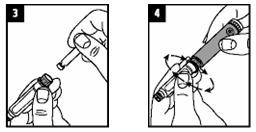
3. Insert the cartridge, metal cap first, into the cartridge holder
4. Lower the pen body onto the cartridge holder so that the black rod presses against the cartridge plunger. Screw the cartridge holder onto the pen body until no gap remains. One of the blue arrows must line-up with the yellow line mark on the pen body.
Note - Do not overtighten.
ATTACHING THE PEN NEEDLE

5. Remove the paper tab from the back of a new pen needle.
6a. Holding the cartridge holder, push the pen needle unit onto the pen. Then screw the threaded hub of the pen needle onto the cartridge holder as shown.
6b. With a gentle pull, remove the outer pen needle shield. Save the outer shield. You will use it to remove the pen needle from the pen after your injection is finished.
6c. Do not remove the inner pen needle shield at this time.
6d. Check that the cartridge holder is attached to the pen body, with the blue arrow lined-up with the yellow mark on the pen body before each injection.
PRIMING
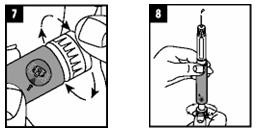
Important - Before using a new cartridge, you must prime the Omnitrope® Pen 5.
For a New Cartridge Only
7. Hold the pen with the needle pointing upwards. Gently tap the cartridge holder with your finger to help air bubbles rise to the top of the cartridge. Set the dose to 0.05 mg (one click) by turning the dose knob.
8. Remove the inner pen needle shield. With the pen needle pointing up, firmly turn the dose knob back to the “0” position and hold for at least 5 seconds. At least 2 drops of medicine must flow out of the pen needle for the pen to be properly primed.
If at least 2 drops do not flow out, set the dose to 0.05 mg and repeat the steps until at least 2 drops of medicine appear at the tip of the pen needle.
When medicine appears, the Omnitrope® Pen 5 is properly primed for injection and ready to use.
For a previously used Cartridge
No priming is needed. Remove the inner pen needle shield and continue with dose dialing.
DOSE DIALING
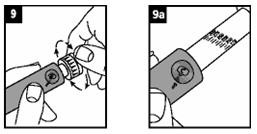
9. To set your dose, turn the dose knob until you see the number of mg for your dose in the middle of the dose window lined-up with the arrow. You will hear a click for each dose increment you dial. However, do not rely on counting these clicks to measure the right dose.
Important - Dose Correction
If you turn the dose knob past your dose, do not dial backwards.
Hold the pen body and turn the dose knob until it is fully extended as shown in picture 9a. You will see a bent arrow ( ) in the dose dialing window. The injection button can now be fully pressed, resetting the dial to “0” without giving medicine. The right dose can now be redialed as described in step 9.
) in the dose dialing window. The injection button can now be fully pressed, resetting the dial to “0” without giving medicine. The right dose can now be redialed as described in step 9.
Note - Check that the cartridge holder is still attached to the pen body, with the blue arrow lined-up with the yellow mark on the pen body.
MAKING THE INJECTION
10. Insert the pen needle into the skin as instructed by your healthcare professional.
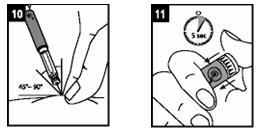
11. After inserting the pen needle, push the injection button in as far in as it will go and press firmly. A clicking sound will be heard while your dose is injecting. Continue to press firmly for at least 5 seconds, before you remove the pen needle from the skin.
If medicine continues to drip from the pen needle after injection, hold the pen needle in your skin for a longer time the next time you inject.
If you cannot push the Injection button in as far in as it goes and the dose window does not read “0”, the cartridge is empty and the full dose of medicine has not been injected. The dose indicator window will show the amount of medicine still needed. Remove the pen needle from the skin and note the number. Reset the dose knob to “0” by holding the pen and turning the dose knob until it is fully extended as shown in picture 9a. The dose injection button can now be fully pressed to “0”. Remove the pen needle from the pen (see step 12 below) and remove the empty cartridge by unscrewing the cartridge holder. Insert a new cartridge and prime the pen as described in steps 7 and 8. Set the dose, which you noted, and inject. This completes your dose.
Important - Before replacing a cartridge, be sure that the pen needle unit is NOT attached to the Omnitrope® Pen 5.
REMOVING THE PEN NEEDLE

12. Carefully replace the outer pen needle shield. Hold the pen by the cartridge holder and unscrew the pen needle from the cartridge holder. Recap the pen.
13. Store your Omnitrope® Pen 5 with attached Omnitrope cartridge in its pouch or refrigerator storage box. Store in a refrigerator between 36 and 46°F (2 and 8°C).
14. Dispose of used pen needles in a special container called a “sharps” container. Your healthcare professional can give you a sharps container or tell you how to make one. Do not dispose of used pen needles in the trash.
| PROBLEM | POSSIBLE CAUSE | HOW TO FIX |
| Dial unit does not turn easily. | Dust or dirt | Turn the dial beyond the highest setting on the scale. Wipe all exposed surfaces with a clean, damp cloth. Please also refer to the chapter “Care and Storage”. |
| You have dialed a higher dose than needed. | Correct dose as described in step 9, “Dose correction”. | |
| The injection button cannot be pushed or stops during injection. (Dose knob does not return to “0”). | Cartridge is empty and full dose has not been dispensed. | Remove the pen needle as per step 12 and replace the empty cartridge with a new cartridge. Refer to step 11, “If the injection button stops”. |
| Clogged pen needle. | Remove the pen needle as per step 12 and replace it with a new needle as described in step 5. | |
| No clicking is heard during the injection (Dose knob moves freely). | Pen is in dose correction mode. | Remove pen needle from skin. Press injection button all the way in so the dial returns to zero and repeat from step 9 to make the injection. |
| Medicine continues to drip from the pen needle after injection. | Pen needle was removed from the skin too early. | Hold the pen needle in your skin longer next time you inject. |
| Cartridge holder is not properly attached to the pen body. | Line-up blue arrow on cartridge holder with yellow mark on pen body. |
CARE AND STORAGE
Once your Omnitrope® Pen 5 contains a somatropin cartridge, it has to be stored in the refrigerator between 36 and 46°F (2 and 8°C).
Protect your Omnitrope® Pen 5 and cartridge from light by storing in its pouch or refrigerator storage box.
The Omnitrope cartridge must be discarded 21 days after the first injection. The Omnitrope® Pen 5 can be reloaded with a new cartridge and be used multiple times.
Your Omnitrope® Pen 5 must be properly cared for.
- Only a clean, damp cloth should be used for routine cleaning. Never wash the pen in water or with strong surgical disinfectants.
- Avoid exposure to dust, moisture and temperature extremes. Do not expose to heat or freeze.
If your Omnitrope® Pen 5 is damaged or you cannot get it to work contact your local Omnitrope® Pen 5 provider (phone 1-800-525-8747). For questions or additional information please call 1-800-525-8747. Do not attempt to repair the pen yourself.
GUARANTEE
Your Omnitrope® Pen 5 is covered by a 2 year guarantee. Contact your local pen provider after you have used the pen for 2 years to have it replaced by a new one.
If your Omnitrope® Pen 5 is defective in materials or workmanship within the period of the guarantee, the local pen provider will replace the Omnitrope® Pen 5 and/or rectify the fault at its own cost.
In case of complaints, please contact your local pen provider to report a complaint.
This guarantee is invalid if your Omnitrope® Pen 5 has not been used in accordance with the manufacturer`s instruction leaflet or if the defect has been caused by neglect, misuse or accident.
ACCURACY - Omnitrope® Pen 5 complies with the accuracy requirements of the International Standard EN ISO11608-1/2000 Pen Injectors for medical use - Requirements and test methods.
IMPORTANT PERSONAL NOTES
Date I first used the Omnitrope® Pen 5: (dd/mm/yy)
Pen log no:
Additional Comments:
SERVICE MATERIALS*
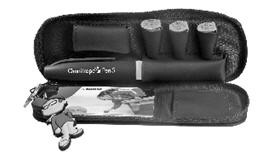
POUCH to store and protect your pen and other components, such as needles
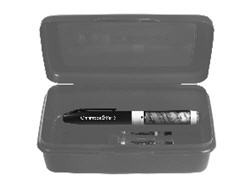
REFRIGERATOR STORAGE BOX to protect the drug from odors and accidental spills
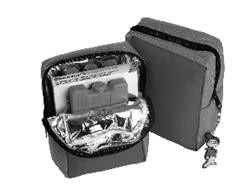
COOLBAG to help maintain Omnitrope® at refrigerator temperature when traveling
*Optional; please check availability with your local Sandoz representative
Omnitrope® is a trademark of Novartis.
BD and BD Logo are trademarks of Becton, Dickinson and Company.
OP5.ifU.07.1
Manufactured by
BD Medical-Pharmaceutical Systems
Franklin Lakes, NJ 07417
Packaged by
Sandoz GmbH, Kundl, Austria
Distributed by
Sandoz Inc., Princeton, NJ 08540
OMNITROPE® PEN 10 INSTRUCTIONS FOR USE
For use with Omnitrope® (Somatropin [rDNA origin] Injection) 10 mg/1.5 mL cartridges
TABLE OF CONTENTS
Important Safety Information
DOs and DON'Ts
Pen Parts
Auto-positioning Feature
Pen Components
How to Use Your Omnitrope® Pen 10
Loading the Cartridge into the Pen
Attaching the Pen Needle
Priming
Dose Dialing
Making the Injection
Removing the Pen Needle
Trouble Shooting
Care and Storage
Guarantee
Important Personal Notes
Service Materials
READ FIRST: Important Safety Information
1. Read the following instructions before using the Omnitrope® Pen 10. Ask your healthcare professional if there is something you do not understand.
2. The Omnitrope® Pen 10 is a pen injector. It is for use with Omnitrope® cartridges 10 mg/1.5 mL (30 IU) and BD® pen needles (29G x 12.7 mm or 31G x 8 mm or 31G x 5 mm).
3. People with very poor vision should not use the Omnitrope® Pen 10 unless someone with good eyesight is able to help.
DOS AND DON'TS
DOs
1. Always keep Omnitrope® cartridges refrigerated.
2. After taking a cartridge out of the refrigerator, allow it to reach room temperature (about 30 minutes) before injecting the medicine.
3. When starting a new cartridge, always ready (prime) the pen.
4. When making an injection, insert the pen needle into the skin in the way that your healthcare professional teaches you. After pen needle insertion, push the injection button in as far as it will go and continue to press firmly for at least five seconds, before you remove the pen needle from the skin. If medicine continues to drip from the pen needle after injection, hold the pen needle in the skin longer the next time you inject.
5. This device must not be shared with other patients. However, if you are giving an injection to another person, be careful when removing the pen needle. Accidental pen needle sticks can transmit infections.
6. For safety and injection comfort, use a new, sterile pen needle with each injection.
DON’Ts
1. Do not share the Omnitrope® Pen 10. It is made for only one person to use.
2. The pen needle unit is sterile. To avoid contaminating the pen needle after opening, do not place it on a surface or touch exposed parts.
3. Never dial your dose or attempt to correct a dialing error with the pen needle in your skin. This may result in a wrong dose.
4. Never store or carry your Omnitrope® Pen 10 with a pen needle attached.
Never recap pen with pen needle on.

Storing or carrying your Omnitrope® Pen 10 with a pen needle attached may lead to needle pricks and leaves an open passage for:
• Air to enter the cartridge
• medicine to leak out
Both of these conditions can affect the dose of the injection.
5. Do not use your Omnitrope® Pen 10 if the cap or other parts are missing.
PEN PARTS
AUTO-POSITIONING FEATURE
The Omnitrope® Pen 10 has a black rod with an auto-positioning feature. This auto-positioning feature makes priming easier (fewer steps), especially when a new cartridge is used.
How it works
(Pictures are included only to demonstrate the auto-positioning feature. These steps are not necessary to operate pen).
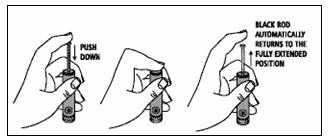
Notice that the black rod moves into the pen easily and returns to the fully extended position automatically. This automatic extension of the black rod positions it correctly against the cartridge plunger.
PEN PARTS
 |
PEN CAP 1. Clip |
 | CARTRIDGE HOLDER |
 |
PEN BODY 2. Black rod 3. Dose window with arrow indicator 4. White dose knob 5. Red injection button |
 |
PEN NEEDLE UNIT 6. Outer pen needle shield 7. Inner pen needle shield 8. Pen needle 9. Hub 10. Paper tab |
Note - Pen Needle Unit is supplied assembled and sterile. Do not disassemble at this point.
 |
CARTRIDGE 11. Rubber septum 12. Metal Cap 13. Cartridge plunger |
HOW TO USE YOUR OMNITROPE® PEN 10
LOADING THE CARTRIDGE INTO THE PEN
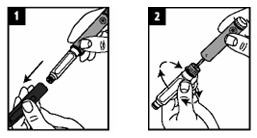
1. Remove the pen cap by pulling it off the pen.
2. Unscrew the cartridge holder from the pen body
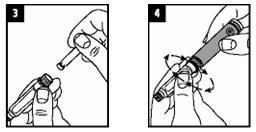
3. Insert the cartridge, metal cap first, into the cartridge holder
4. Lower the pen body onto the cartridge holder so that the black rod presses against the cartridge plunger. Screw the cartridge holder onto the pen body until no gap remains. One of the blue arrows must line-up with the white line mark on the pen body.
Note - Do not overtighten.
ATTACHING THE PEN NEEDLE
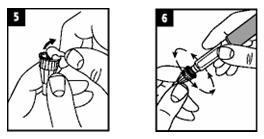
5. Remove the paper tab from the back of a new pen needle.
6a. Holding the cartridge holder, push the pen needle unit onto the pen. Then screw the threaded hub of the pen needle onto the cartridge holder as shown.
6b. With a gentle pull, remove the outer pen needle shield. Save the outer shield. You will use it to remove the pen needle from the pen after your injection is finished.
6c. Do not remove the inner pen needle shield at this time.
6d. Check that the cartridge holder is attached to the pen body, with the blue arrow lined-up with the white mark on the pen body before each injection.
PRIMING
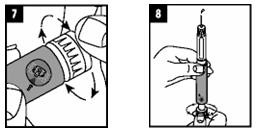
Important - Before using a new cartridge, you must prime the Omnitrope® Pen 10.
For a New Cartridge Only
7. Hold the pen with the needle pointing upwards. Gently tap the cartridge holder with your finger to help air bubbles rise to the top of the cartridge. Set the dose to 0.1 mg (one click) by turning the dose knob.
8. Remove the inner pen needle shield. With the pen needle pointing up, firmly turn the dose knob back to the “0” position and hold for at least 5 seconds. At least 2 drops of medicine must flow out of the pen needle for the pen to be properly primed.
If at least 2 drops do not flow out, set the dose to 0.1 mg and repeat the steps until at least 2 drops of medicine appear at the tip of the pen needle.
When medicine appears, the Omnitrope® Pen 10 is properly primed for injection and ready to use.
For a previously used Cartridge
No priming is needed. Remove the inner pen needle shield and continue with dose dialing.
DOSE DIALING

9. To set your dose, turn the dose knob until you see the number of mg for your dose in the middle of the dose window lined-up with the arrow. You will hear a click for each dose increment you dial. However, do not rely on counting these clicks to measure the right dose.
Important - Dose Correction
If you turn the dose knob past your dose, do not dial backwards.
Hold the pen body and turn the dose knob until it is fully extended as shown in picture 9a. You will see a bent arrow ( ) in the dose dialing window. The injection button can now be fully pressed, resetting the dial to “0” without giving medicine. The right dose can now be redialed as described in step 9.
) in the dose dialing window. The injection button can now be fully pressed, resetting the dial to “0” without giving medicine. The right dose can now be redialed as described in step 9.
Note - Check that the cartridge holder is still attached to the pen body, with the blue arrow lined-up with the white mark on the pen body.
MAKING THE INJECTION
10. Insert the pen needle into the skin as instructed by your healthcare professional.

11. After inserting the pen needle, push the injection button in as far in as it will go and press firmly. A clicking sound will be heard while your dose is injecting. Continue to press firmly for at least 5 seconds, before you remove the pen needle from the skin.
If medicine continues to drip from the pen needle after injection, hold the pen needle in your skin for a longer time the next time you inject.
If you cannot push the Injection button in as far in as it goes and the dose window does not read “0”, the cartridge is empty and the full dose of medicine has not been injected. The dose indicator window will show the amount of medicine still needed. Remove the pen needle from the skin and note the number. Reset the dose knob to “0” by holding the pen and turning the dose knob until it is fully extended as shown in picture 9a. The dose injection button can now be fully pressed to “0”. Remove the pen needle from the pen (see step 12 below) and remove the empty cartridge by unscrewing the cartridge holder. Insert a new cartridge and prime the pen as described in steps 7 and 8. Set the dose, which you noted, and inject. This completes your dose.
Important - Before replacing a cartridge, be sure that the pen needle unit is NOT attached to the Omnitrope® Pen 10.
REMOVING THE PEN NEEDLE

12. Carefully replace the outer pen needle shield. Hold the pen by the cartridge holder and unscrew the pen needle from the cartridge holder. Recap the pen.
13. Store your Omnitrope® Pen 10 with attached Omnitrope cartridge in its pouch or refrigerator storage box. Store in a refrigerator between 36 and 46°F (2 and 8°C).
14. Dispose of used pen needles in a special container called a “sharps” container. Your healthcare professional can give you a sharps container or tell you how to make one. Do not dispose of used pen needles in the trash.
| PROBLEM | POSSIBLE CAUSE | HOW TO FIX |
| Dial unit does not turn easily. | Dust or dirt | Turn the dial beyond the highest setting on the scale. Wipe all exposed surfaces with a clean, damp cloth. Please also refer to the chapter “Care and Storage”. |
| You have dialed a higher dose than needed. | Correct dose as described in step 9, “Dose correction”. | |
| The injection button cannot be pushed or stops during injection. (Dose knob does not return to “0”). | Cartridge is empty and full dose has not been dispensed. | Remove the pen needle as per step 12 and replace the empty cartridge with a new cartridge. Refer to step 11, “If the injection button stops”. |
| Clogged pen needle. | Remove the pen needle as per step 12 and replace it with a new needle as described in step 5. | |
| No clicking is heard during the injection (Dose knob moves freely). | Pen is in dose correction mode. | Remove pen needle from skin. Press injection button all the way in so the dial returns to zero and repeat from step 9 to make the injection. |
| Medicine continues to drip from the pen needle after injection. | Pen needle was removed from the skin too early. | Hold the pen needle in your skin longer next time you inject. |
| Cartridge holder is not properly attached to the pen body. | Line-up blue arrow on cartridge holder with white mark on pen body. |
CARE AND STORAGE
Once your Omnitrope® Pen 10 contains a somatropin cartridge, it has to be stored in the refrigerator between 36 and 46°F (2 and 8°C).
Protect your Omnitrope® Pen 10 and cartridge from light by storing in its pouch or refrigerator storage box.
The Omnitrope cartridge must be discarded 28 days after the first injection. The Omnitrope® Pen 10 can be reloaded with a new cartridge and be used multiple times.
Your Omnitrope® Pen 10 must be properly cared for.
- Only a clean, damp cloth should be used for routine cleaning. Never wash the pen in water or with strong surgical disinfectants.
- Avoid exposure to dust, moisture and temperature extremes. Do not expose to heat or freeze.
If your Omnitrope® Pen 10 is damaged or you cannot get it to work contact your local Omnitrope® Pen 10 provider (phone 1-800-525-8747). For questions or additional information please call 1-800-525-8747. Do not attempt to repair the pen yourself.
GUARANTEE
Your Omnitrope® Pen 10 is covered by a 2 year guarantee. Contact your local pen provider after you have used the pen for 2 years to have it replaced by a new one.
If your Omnitrope® Pen 10 is defective in materials or workmanship within the period of the guarantee, the local pen provider will replace the Omnitrope® Pen 10 and/or rectify the fault at its own cost.
In case of complaints, please contact your local pen provider to report a complaint.
This guarantee is invalid if your Omnitrope® Pen 10 has not been used in accordance with the manufacturer`s instruction leaflet or if the defect has been caused by neglect, misuse or accident.
ACCURACY - Omnitrope® Pen 10 complies with the accuracy requirements of the International Standard EN ISO11608-1/2000 Pen Injectors for medical use - Requirements and test methods.
IMPORTANT PERSONAL NOTES
Date I first used the Omnitrope® Pen 10: (dd/mm/yy)
Pen log no:
Additional Comments:
SERVICE MATERIALS*
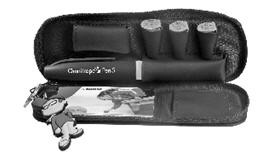
POUCH to store and protect your pen and other components, such as needles
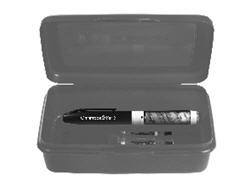
REFRIGERATOR STORAGE BOX to protect the drug from odors and accidental spills
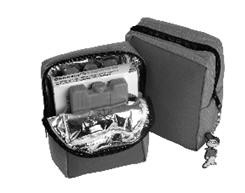
COOLBAG to help maintain Omnitrope® at refrigerator temperature when traveling
*Optional; please check availability with your local Sandoz representative
Omnitrope® is a trademark of Novartis.
BD and BD Logo are trademarks of Becton, Dickinson and Company.
OP10.ifU.07.1
Manufactured by
BD Medical-Pharmaceutical Systems
Franklin Lakes, NJ 07417
Packaged by
Sandoz GmbH, Kundl, Austria
Distributed by
Sandoz Inc., Princeton, NJ 08540
INSTRUCTIONS FOR OMNITROPE® 1.5 MG/VIAL
The following instructions explain how to inject OMNITROPE® 1.5 mg. Do not inject OMNITROPE® yourself until your healthcare provider has taught you and you understand the instructions. Ask your healthcare provider or pharmacist if you have any questions about injecting OMNITROPE®.
- OMNITROPE® 1.5 mg is for single use.
- The concentration of OMNITROPE® after mixing is 1.3 mg/mL.
Preparation
Collect necessary items before you begin:

- a vial with OMNITROPE® 1.5 mg
- a vial with diluent (mixing liquid - Sterile Water for Injection) for OMNITROPE® 1.5 mg
- a sterile, disposable 3 mL syringe and needle for withdrawing the diluent from the vial (not supplied in the pack)
- sterile disposable 1 mL syringes and needles for under the skin (subcutaneous) injection (not supplied in the pack)
- 2 alcohol swabs (not supplied in the pack)
Wash your hands before you start with the next steps.

Mixing OMNITROPE® 1.5 mg
- Remove the protective caps from the two vials. With one alcohol swab, clean both the rubber top of the vial that contains the powder and the rubber top of the vial that contains diluent.
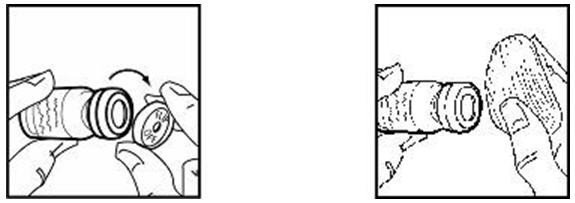
- Use next the sterile diluent vial, the disposal 3 mL syringe and a needle.
- Attach the needle to the syringe (if not attached already). Pull back the syringe plunger and fill the syringe with air. Push the needle fitted to the syringe through the rubber top of the diluent vial, push all the air from the syringe into the vial, turn the vial upside down, and withdraw all the diluent from the vial into the syringe. Remove the syringe and needle.

- Next take the syringe with the diluent in it and push the needle through the rubber stopper of the vial that contains the white powder. Inject the diluent slowly. Aim the stream of liquid against the glass wall in order to avoid foam. Remove the syringe and needle and dispose of them.

- Gently swirl the vial until the content is completely dissolved.
Do not shake.
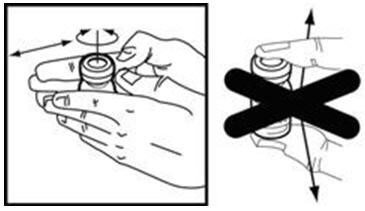
- If the medicine is cloudy or contains particles, it should not be used. The medicine must be clear and colorless after mixing.
- After mixing the medicine use the solution immediately or at a maximum 24 hours after reconstitution.
Measuring the Dose of OMNITROPE® 1.5 mg to Be Injected
- Next use the sterile, disposable 1 mL (or similar) syringe and needle for subcutaneous injection. Push the needle through the rubber top of the vial that contains the medicine that you have just mixed.
- Turn the vial and the syringe upside down.

- Be sure the tip of the syringe is in the OMNITROPE® mixed medicine.
- Pull back on the plunger slowly and withdraw the dose prescribed by your doctor into the syringe.
- Hold the syringe with the needle in the vial pointing up and remove the syringe from the vial.
- Check for air bubbles in the syringe. If you see any bubbles, pull the plunger slightly back; tap the syringe gently, with the needle pointing upwards, until the bubble disappears. Push the plunger slowly back up to the correct dose. If there is not enough medicine in the syringe after removing the air bubbles, draw more medicine into the syringe from the mixed medicine vial and repeat checking for bubbles.
- Look at the mixed medicine in the syringe before using. Do not use if discolored or particles are present. You are now ready to inject the dose.
Injecting OMNITROPE® 1.5 mg
- Choose the site of injection on your body. The best sites for injection are tissues with a layer of fat between skin and muscle such as the upper leg (thigh), buttocks, or stomach area (abdomen) as in the picture shown below. Do not inject near your belly button (navel) or waistline.

- Make sure you rotate the injection sites on your body. Inject at least 1/2 inch from the last injection. Change the places on your body where you inject, as you have been taught.
- Before you make an injection, clean your skin well with an alcohol swab. Wait for the area to air dry.
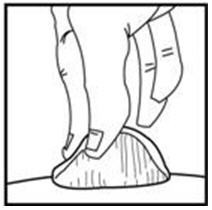
- With one hand, pinch a fold of loose skin at the injection site. With your other hand, hold the syringe as you would a pencil. Insert the needle into the pinched skin straight in or at a slight angle (an angle of 45° to 90°). After the needle is in, remove the hand used to pinch the skin and use it to hold the syringe barrel. Pull back the plunger very slightly with one hand. If blood comes into the syringe, the needle has entered a blood vessel. Do not inject into this site; withdraw the needle and repeat the procedure at a different site. If no blood comes into the syringe, inject the solution by pushing the plunger all the way down gently.
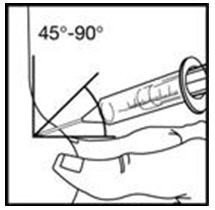
- Pull the needle straight out of the skin. After injection, press the injection site with a small bandage or sterile gauze if needed for bleeding, for several seconds. Do not massage or rub the injection site.
After Injecting OMNITROPE® 1.5 mg
- Discard the vials and injection materials.
- Dispose the syringes safely in a closed container. You can ask your healthcare provider or pharmacist for a “sharps” container. A sharps container is a special container to put used needles and syringes in. You can return a full sharps container to your pharmacist or healthcare provider for disposal.
Omnitrope® is a trademark of Novartis.
92 238 5
Manufactured in Austria by Sandoz GmbH
Distributed by Sandoz Inc., Princeton, NJ 08540
INSTRUCTIONS FOR OMNITROPE® 5.8 MG/VIAL
The following instructions explain how to inject OMNITROPE® 5.8 mg. Do not inject OMNITROPE® yourself until your healthcare provider has taught you and you understand the instructions. Ask your healthcare provider or pharmacist if you have any questions about injecting OMNITROPE®.
- OMNITROPE® 5.8 mg is for multiple uses.
- The concentration of OMNITROPE® after mixing is 5 mg/mL.
- After mixing, OMNITROPE® 5.8 mg contains a preservative and should not be used in newborns.
Preparation
Collect necessary items before you begin:
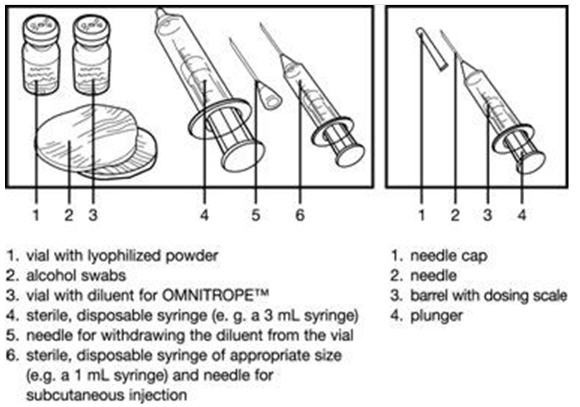
- a vial with OMNITROPE® 5.8 mg
- a vial with diluent (mixing liquid - Bacteriostatic Water for Injection containing benzyl alcohol as preservative) for OMNITROPE® 5.8 mg
- a sterile, disposable 3 mL syringe and needle for withdrawing the diluent from the vial (not supplied in the pack)
- sterile disposable 1 mL syringes and needles for under the skin (subcutaneous) injection (not supplied in the pack)
- 2 alcohol swabs (not supplied in the pack)
Wash your hands before you start with the next steps.

Mixing OMNITROPE® 5.8 mg
- Remove the protective caps from the two vials. With one alcohol swab, clean both the rubber top of the vial that contains the powder and the rubber top of the vial that contains diluent.
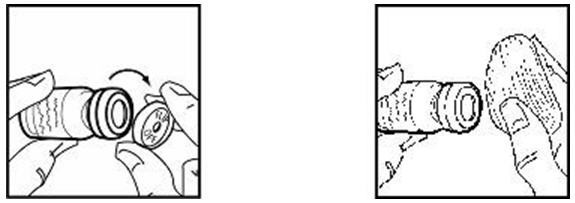
- Use next the sterile diluent vial, the disposal 3 mL syringe and a needle.
- Attach the needle to the syringe (if not attached already). Pull back the syringe plunger and fill the syringe with air. Push the needle fitted to the syringe through the rubber top of the diluent vial, push all the air from the syringe into the vial, turn the vial upside down, and withdraw all the diluent from the vial into the syringe. Remove the syringe and needle.
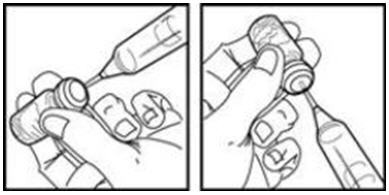
- Next take the syringe with the diluent in it and push the needle through the rubber stopper of the vial that contains the white powder. Inject the diluent slowly. Aim the stream of liquid against the glass wall in order to avoid foam. Remove the syringe and needle and dispose of them.
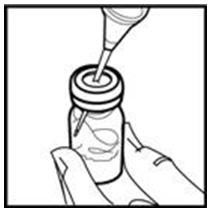
- Gently swirl the vial until the content is completely dissolved. Do not shake.

- If the medicine is cloudy or contains particles, it should not be used. The medicine must be clear and colorless after mixing.
- After mixing the medicine, the medicine in the vial must be used within 3 weeks. Store the vial in a refrigerator at 2° to 8°C (36° to 46°F) after mixing and using it each time.
Measuring the Dose of OMNITROPE® 5.8 mg to Be Injected
- Next use the sterile, disposable 1 mL (or similar) syringe and needle for subcutaneous injection. Push the needle through the rubber top of the vial that contains the medicine that you have just mixed.
- Turn the vial and the syringe upside down.

- Be sure the tip of the syringe is in the OMNITROPE® mixed medicine.
- Pull back on the plunger slowly and withdraw the dose prescribed by your doctor into the syringe.
- Hold the syringe with the needle in the vial pointing up and remove the syringe from the vial.
- Check for air bubbles in the syringe. If you see any bubbles, pull the plunger slightly back; tap the syringe gently, with the needle pointing upwards, until the bubble disappears. Push the plunger slowly back up to the correct dose. If there is not enough medicine in the syringe after removing the air bubbles, draw more medicine into the syringe from the mixed medicine vial and repeat checking for bubbles.
- Look at the mixed medicine in the syringe before using. Do not use if discolored or particles are present. You are now ready to inject the dose.
Injecting OMNITROPE® 5.8 mg
- Choose the site of injection on your body. The best sites for injection are tissues with a layer of fat between skin and muscle such as the upper leg (thigh), buttocks, or stomach area (abdomen) as in the picture shown below. Do not inject near your belly button (navel) or waistline.

- Make sure you rotate the injection sites on your body. Inject at least 1/2 inch from the last injection. Change the places on your body where you inject, as you have been taught.
- Before you make an injection, clean your skin well with an alcohol swab. Wait for the area to air dry.
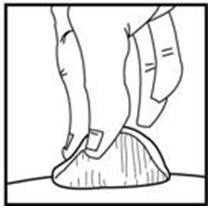
- With one hand, pinch a fold of loose skin at the injection site. With your other hand, hold the syringe as you would a pencil. Insert the needle into the pinched skin straight in or at a slight angle (an angle of 45° to 90°). After the needle is in, remove the hand used to pinch the skin and use it to hold the syringe barrel. Pull back the plunger very slightly with one hand. If blood comes into the syringe, the needle has entered a blood vessel. Do not inject into this site; withdraw the needle and repeat the procedure at a different site. If no blood comes into the syringe, inject the solution by pushing the plunger all the way down gently.

- Pull the needle straight out of the skin. After injection, press the injection site with a small bandage or sterile gauze if needed for bleeding, for several seconds. Do not massage or rub the injection site.
After Injecting OMNITROPE® 5.8 mg
- Discard the injection materials.
- Dispose the syringes safely in a closed container. You can ask your healthcare provider or pharmacist for a “sharps” container. A sharps container is a special container to put used needles and syringes in. You can return a full sharps container to your pharmacist or healthcare provider for disposal.
- The vial of mixed medicine must be stored in the refrigerator in its carton at 2° to 8°C (36° to 46°F) and used within 3 weeks.
- The solution should be clear after removal from the refrigerator. If the solution is cloudy or contains particles, discard the vial. Do not inject the medicine from this vial. Start over with a new vial of OMNITROPE® 5.8 mg. Call your pharmacist if you need a replacement.
- Before each use disinfect the rubber top of the reconstituted vial with an alcohol swab. You must use a new disposable 1 mL syringe and needle for each injection.
Omnitrope® is a trademark of Novartis.
08-2008
92 238 5
Manufactured in Austria by Sandoz GmbH
Distributed by Sandoz Inc., Princeton, NJ 08540
| OMNITROPE
somatropin injection, solution |
|||||||||||||||||||||||||||||||||
|
|||||||||||||||||||||||||||||||||
|
|||||||||||||||||||||||||||||||||
|
|||||||||||||||||||||||||||||||||
|
|||||||||||||||||||||||||||||||||
| OMNITROPE
somatropin kit |
|||||||||||||||||||
|
|||||||||||||||||||
|
|||||||||||||||||||
|
|||||||||||||||||||
|
|||||||||||||||||||
|
|||||||||||||||||||
|
|||||||||||||||||||
|
|||||||||||||||||||
|
|||||||||||||||||||
|
|||||||||||||||||||
|
|||||||||||||||||||
|
|||||||||||||||||||
|
|||||||||||||||||||
|
|||||||||||||||||||
| OMNITROPE
somatropin kit |
|||||||||||||||||||
|
|||||||||||||||||||
|
|||||||||||||||||||
|
|||||||||||||||||||
|
|||||||||||||||||||
|
|||||||||||||||||||
|
|||||||||||||||||||
|
|||||||||||||||||||
|
|||||||||||||||||||
|
|||||||||||||||||||
|
|||||||||||||||||||
|
|||||||||||||||||||
|
|||||||||||||||||||
|
|||||||||||||||||||
| OMNITROPE
somatropin injection, solution |
|||||||||||||||||||||||||||||||||
|
|||||||||||||||||||||||||||||||||
|
|||||||||||||||||||||||||||||||||
|
|||||||||||||||||||||||||||||||||
|
|||||||||||||||||||||||||||||||||
Revised: 09/2008Sandoz Inc.